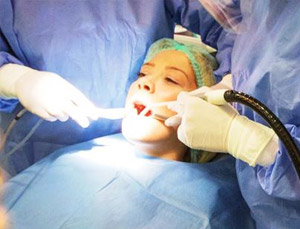After the dental treatment is determined, some sedatives, sarcotic analgesics and...

We have a 10-Bed service at Dentistanbul dental hospital and a full-fledged operating room and have general anesthesia or sedation and surgical (tooth extraction, gingival treatment, implant , bone graft, bone cyst etc.).) and non-surgical (filling, root canal treatment, etc.)) treatments are applied.
What Is Sedation?
After the tooth treatment to be applied to the patient is determined, some sedative(diazem-like), sarcotic analgesic(morphine-like) and sometimes hypnotic drug combined with a patient relaxes and a short amnesia (amnesia) is provided, local anesthesia, the patient's treatment is completed in a short time.
What Is General Anesthesia?
General anesthesia, known as narcosis in the folk language, is provided by the combination of three main groups of drugs.
- Temporary loss of consciousness of the patient with the help of hypnotic drugs,
- Narcotic analgesics applied(morphine - like painkillers) even if the patient unconscious to undergo a painless operation, - muscle relaxants(curry) with all the muscles in the body relaxes the comfortable surgical environment is provided. A small tube is placed in the trachea and the patient's breathing is provided by an anesthesia (breathing device) under the supervision of an anesthesia specialist.
Complications Of Anesthesia
Because of the advances in medicine, the side effects of the drugs used in anesthesia are reduced considerably and are rapidly excreted from the body. In addition, all vital findings of the patients can be monitored very closely with the current medical technology and anesthesia devices and patient monitorization. Because of these reasons, as long as anesthesia is performed by experienced specialists, complications associated with anesthesia (general or sedation) are very rare. Our patients should be hungry for at least 8 hours before the anesthesia.
Pre-op anesthesia review

Our patients who prefer dentistanbul, their needs are determined and dental treatments are planned by the relevant departments and pre-op anesthesia examinations are performed. In anesthesia examination, first of all, the patient's detailed resume (previous surgery and diseases, continuous use of drugs, etc.).) the information is obtained and physical examination takes place. After the necessary examinations are done, the appointment is given...
Anesthesia Risk Groups
- Patients who do not have any health problems and who have the least risks of anesthesia.
- A group of patients with mild illness, such as diabetes and hypertension, but did not affect the functions of life.
- A group of patients whose life functions such as heart failure, respiratory failure are affected and who have a high risk of anesthesia.
- A group of patients with severe heart, liver, kidney and respiratory failure.
General anesthesia and sedation
Children and adult patients can be examined in 5 groups.
- Children under 4 years of age(this group of children persuaded by way of dental treatment is quite difficult)
- Children with developmental delays or adults.
- Adult patients with severe phobia.
- Surgical procedures requiring general anesthesia (bone graft, bone cyst, etc.))
- A group of patients who want to be performed under general anesthesia in a short period of time (2-3 hours) of surgical operations that are not possible to be performed in a single session with local anesthesia.